In today’s era of sound engineering, digital audio has taken center stage, transforming the ways we create, consume, and manipulate music. Its rise to prominence necessitates an in-depth comprehension of its workings, including the possible glitches and distortions inherent in the system. This journey into the world of digital audio takes us through its fundamental concepts, from the basic principles of its operation, its advantage over analog counterparts to its nitty-gritty characteristics. We dissect the phenomena of clipping, aliasing, and jitter, shedding light on their core principles and their effects on our music, while concurrently presenting strategies to combat these distortions for optimal audio quality.
Understanding Digital Audio
The symphony of sound that we have come to know as music has been the lifeblood of civilization for millennia. From the rhythmic pounding of sticks in tribal gatherings to the sophisticated manipulation of digital sounds, music has truly evolved, yet it retains its pristine nature of reaching into our spirits and unbinding the chains that fetter us. In the contemporary system of sound arrangement, one innovation stands tall, casting a profound shadow on direct acoustics: digital audio in music. It holds a beauty so profound, and complexity so enormous, that it transforms the ephemeral into the tangible, making music a truly consumable and transformative art.
Dive into the uniquely captivating aura and you will discover why digital audio has become a triumphant symphony in itself, shaking the very foundations of musical creation, appreciation and distribution. Digital audio unearths an insatiable thirst for perfection, providing recording artists with the opportunity to create, edit, and replicate perfect renditions of their compositions. Gone are the days when musicians had to rely solely on acoustic perfection and hours of retakes to recreate the optimal version of their work. Digital audio equips artists with the flexibility they need to manipulate and sculpt every note, every harmony, and every beat.
Yet the beauty of digital audio is not just in its creation, but in the listening experience, it provides. This dynamic form of artistry allows for an inconceivable audio quality that pierces the veil of standard comprehension, giving the listener an immersive experience impossible to recreate without it. Whether it’s the tingling sensation from a perfectly engineered bass drop or the subtle echo of an acoustic guitar, this powerful tool enables audio engineers to fine-tune every detail of a musical piece, elevating the experience for those at the receiving end.
Despite its undeniable allure, one must not overlook the complexity that dances behind the scenes. The transformation of raw sounds into a seamless flow of digital audio requires an intricate process of sampling, quantization, and encoding. Each step is crucial, demanding a labor of precision and understanding only known to diligent audio engineers who have mastered the craft. It’s a harmonious blend of mathematics, physics, and sound technical knowledge, translated into an art form that transcends ordinary music comprehension.
Remarkably, digital audio is a universal sculptor, bestowing its gifts upon a vast range of music genres. Its artistry is not genre-biased, it reverberates through the pulsating beats of EDM, works magic in the ethereal realms of classical compositions, and breathes life into the raw power of rock and roll. Through digital audio, every genre can attain an unprecedented level of precision and polish.
The beauty and complexity of digital audio lie not simply in the pure virtuosity of sound but in its power to transcend borders, unite cultures, and democratize music. A digital audio file, in all its simplicity and complexity, bridges oceans allowing a teenager in the heartland to connect with a Busker halfway across the globe. It has emancipated music from the physical, ushering it into a realm built purely of bites and bits, where it can be enjoyed in its exalted form, far and wide.
Digital audio in music is more than a technological marvel. It is the driving force of our ever-evolving music culture, and a testament to human creativity and expression. It plunges musicians and listeners alike into a dance with sound, enhancing every twist, every turn, and elevating the shared experience to extraordinary heights.
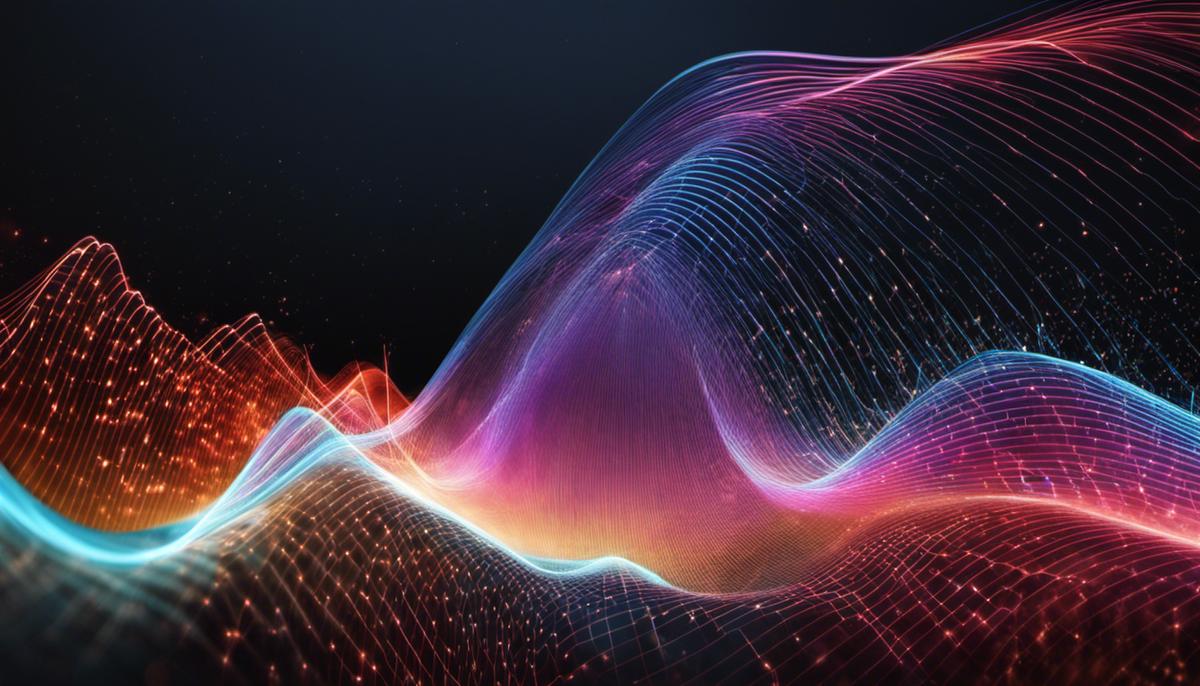
Decoding Clipping
As we plunge further into the technicolor tapestry of musical virtuosity, we find ourselves fixed in a digital domain. This sphere, for all its prismatic versatility, is not free of imperfections – namely, the sinister phantom known as clipping, a distorter of our revered rhythms and euphoric entrancements.
Clipping is the audible distortion that occurs when an audio signal attempts to cross the limits of amplitude, pushing past the maximum decibel levels capable of being reproduced by any given system. This transgression creates a sharp, undesired cut-off, transforming notes that once sung into unmelodious monsters.
Digital audio is engineered precision, a meticulously calculated array of bits and bytes. But in the avaricious pursuit of loudness, we find this precision falling into a veritable pandemonium. The introduction of clipping is a liquefying lava-lamp of loudness war casualties. Artists and producers striving for maximum auditory impact often fall into the trap of over-amplification, causing peaks of their musical composition to be truncated or flattened, generating the distinctive distorted noise.
Modernity has swaddled us in a universe of cinematically sweeping orchestral scores and foot-thumping electronic beats. But without careful attention paid to the beast of clipping, we risk tarnishing these melodious masterpieces of artistry. Floating through the pulsating veins of euphoric beats and lofty tunes, digital audio’s insidious doppelganger can swiftly turn sonic ecstasy into ear-splitting agony, muting the intricacies of harmonies, and erasing the delicate echoes of an artist’s soul-song.
So, we take a beat – pause the ascent into booming decibels – to administer an antidote to this menacing malady. In this technicolor realm, vigilance is the watchword. Cue the music, and let the sound engineering arts serve their purpose of protecting the integrity of our digital symphonies. The tools that offer us the ability to shape, rearrange, and refine sounds can also keep clipping in check.
From dynamic range compressors to soft limiters and automated level control plugins, there is a pantheon of audio processing solutions. These tools regulate volume levels, prevent amplitude spikes, and preserve the intimate nuances of every strum, beat, and chorus. They ensure that each electronically engineered note can surge unfettered, with full-bodied vibrancy, through our headphones and speakers, without succumbing to the dread distortion of clipping.
In the realm of digital audio, the symphony of sound bites sculpted into melodies, harmonies, and rhythms is an unending tableau of precision. Amidst this pixelated pantheon of sound, we are behooved to serve as the guardians of musical fidelity. Ensuring our beloved scores remain untarnished by the clawing hands of clipping is a testament to our collective love and reverence for the transformative power of music.
The enigmatic universe of melodies, timbres, and rhythms is a playground of infinite possibilities. Despite the lurking ghost of clipping, all we need is a keen ear and relentless determination to extract the true essence of our favorite tunes. After all, music is about feeling the pulse of the beat, echoing the rhythm of our hearts, and guiding us on an exhilarating voyage across the boundless sea of emotion. So, here’s to preserving our treasured tunes and crowd-moving beats from the phantom that is clipping, and to exploring the vast, vibration-filled void of the digital audio cosmos.

Aliasing Unveiled
Amidst the crescendo of digital music symphonies and harmonious human-machine collaborations, aliasing stands as an intriguing concept that often nudges on one’s perception of audio. The subtle beast of aliasing strikes a harmony of technicality and abstraction, subtly shaping the listening experience of each Audiophile.
Aliasing, a distinctly digital phenomenon, gracefully waltz into the scene when a piece of audio is converted from an analog signal into a digital signal. Temporarily defying the immersive, life-enveloping symphonies, we delve into this transformation, delicately stripping away the magic to illuminate the machinery underneath. The grating hip-hop beat, the soulful strains of a violin, the pulsating rhythm of techno – they all dance to the tune of this digital rendering.
Let’s condense the concept of aliasing to a simple, audaciously oversimplified explanation – it’s like an agile pickpocket in a crowded subway car, stealthily morphing the musical note while its soul is in digital conversion. This transforming process closely listens to the enactment of the ‘Nyquist-Shannon sampling theorem,’ which propounds that audio must be sampled at least twice the highest frequency. An overture in ignorance of this rule ushers aliasing into the extraordinary spectacle of music.
In the realm of digital audio, aliasing isn’t simply a nuance to purists in search of tonal perfection, but it significantly alters the integrity of the music, enveloping it with an uninvited layer of distortion. Imagine it as an uninvited guest who saunters onto the stage in the middle of the philharmonic symphony, casually playing bagpipes.
Yet, in pure defiance of acoustic precision, some composers playfully flirt with aliasing. In electronic music, especially in genres radiating a raw, metallic edge, aliasing is purposefully induced to render a texture that’s sublimely grunge and cutting-edge. A daring sound designer may even surgically wield aliasing as a chisel, sculpting an element of ‘imperfection’ that makes their symphony truly human.
However, it’s essential to keep one’s musical ears keen and vigilant of unwelcome aliasing in general music appreciation. Tools, software, and digital filters exist, offering a firewall against this unwelcome distortion. It is these detailed nuances and the interplay between technology and raw, passionate music that brings about a uniquely digital flavor to the vast symphonic landscape.
The story of aliasing in digital audio is a story of borders crossed and frontiers explored, seeking to capture the excitement of tones and beats within the finite confinements of digital encoding. From the enigmatic whisperings of aliasing comes a cue to reconcile the perfection offered by digital precision with the undulating, unpredictable beauty of raw notes. Undeniably, the thrilling saga of sound engineering underscores the infinite power of music as an indomitable area where technology dances to the rhythm and beat of creativity, and not the other way around. Steeped in this understanding, the act of enjoying music takes on a different note, becoming part of a larger experience, an expansive language that unites us all in the digital age.
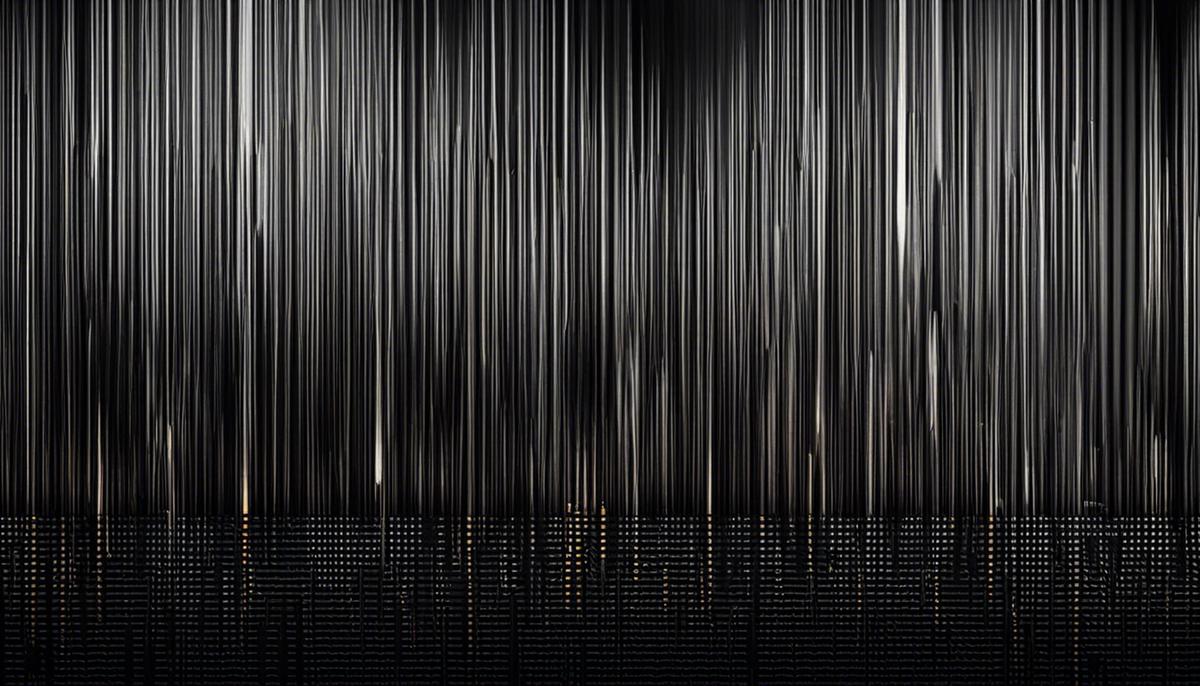
Jitter: An Unseen Alterer
Striding further into the invigorating landscape of digital audio, many music enthusiasts and audiophiles alike encounter the enigma of jitter. This obscure phenomenon, often sidelines, wields a subtle influence over the musical journeys each of us embarks on.
Like an unpredictable current beneath the glassy surfaces of digital music, jitter can alter the course of audio signals. It refers to the temporal variations of a digital signal’s fundamental pulse, typically manifesting as slight anomalies in timing precision during signal conversion. Although seemingly trivial, these small disruptions can trigger substantial changes in the resulting sound, infusing it with slight blots of distortion.
Jitter rests at the crossroads of music and technology, embodying the dual nature of the digital music experience. It’s an offbeat drummer, hijacking an otherwise flawless rhythm, turning perfection into acoustic authenticity with its unusual tempo.
Diving into the chaotic beauty of live performances, it is jitter’s invisible hand that transforms a polished studio recording into a unique, on-the-spot creation. This slight irregularity breathes life and spontaneity into the digital world, preserving the raw authenticity of music that often risks being watered down in the digitization process.
However, unchecked jitter can lead to a disorienting labyrinth of distortion. This can permeate our listening experiences, rendering symphonies that were originally harmonious into jarring, divergent compositions. Chasing the immersive, high-definition experience of digital audio, enthusiasts are often driven to grapple with jitter, striving for a delicate balance between its creative potential and disruptive tendencies.
Though jitter poses a gnawing challenge to sound engineers, it has catalyzed pioneering developments in audio technology. Anti-jitter circuits, clock recovery techniques, and high precision oscillators are among the arsenal employed to minimize the indelible fingerprints of jitter. Just as music festivals bring together disparate notes under a unified melody, engineers and enthusiasts join forces in their shared pursuit of harmony in digital music.
Delving into the imaginative realm of electronic music, artists are experimenting with controlled introduction of jitter to push boundaries. This deliberate dalliance with disruption challenges traditional ideas of perfection, bringing forth innovative soundscapes that invite the listener into a vibrant conversation.
Jitter underscores the symbiotic relationship between man and machine, where music’s emotional ardor dances with digital precision. The phenomenon reminds us that even within the perfectly calculated world of bits and pixels, there lies a certain sense of randomness and freedom akin to improvising a guitar riff or adding a new beat to a rhythm.
As our digitized melodies continue to reverberate across borders, so too does jitter accompany us, whimsically twisting our perceptions of sound and rhythm. It subtly challenges us to not merely hear, but intimately listen to the intricate nuances in music. This is a reminder that even in the digital matrix of music, there’s still a need for human touch, instinct, and a discerning ear.
In the grand symphony of music that animates our life, jitter weaves its own unpredictable melody, shaping and coloring the harmonies that echo in our ears. The phenomenon is not just a glitch in the digital realm, but a partner in our musical journeys, inspiring us to reimagine sound in new and exciting ways. Perhaps, in every journey that music takes us on, we ought to welcome a little jitter to keep us on the edge, to remind us of the joy of unexpected turns, and the thrill of forging untamed rhythms.

As we unravel the veil of digital audio’s complex landscape, it is clear that understanding its intricacies, such as clipping, aliasing, and jitter, is crucial for music enthusiasts and hobbyists. Mastery of these concepts presents the golden key to unlocking the full potential of music in a digital age. With knowledge on how these distortions occur, their implications on sound quality and strategies to mitigate them, we equip ourselves with the power to revolutionize the way we create and appreciate music. Ultimately, deriving the sheer joy and satisfaction of sound in its purest form is intrinsically linked to the profound knowledge of the sophisticated world of digital audio.
In the realm of sound recording and music production, the devil is often in the details. One such detail is microphone bleed—a phenomenon both loved and loathed by sound engineers and enthusiasts alike. It’s an intricate dance where sound leakage between different microphones in a recording setup can become a nemesis or an unexpected ally. Indeed, mastering the concept, causes, and control of microphone bleed can shape the quality of a recording significantly. From explaining the technicalities to exploring its implications, from discussing ways to minimize bleed to post-production adjustments; let’s delve into the subtle world of microphone bleed and demystify its workings.
Understanding Microphone Bleed
On the pulsating heart of musical creation, amidst the enchantingly resonating symphonies of sound, there exists the less-noted, less-romanticized but utterly integral player: the almighty microphone. Yet, like any performance, be it a poignant indie ballad or an electrifying rock anthem, there exists a hidden nemesis, an unseen hiccup in the otherwise immaculate symphony of sound. This culprit, often just as omnipresent as the microphone itself, is the phenomenon known as microphone bleed.
Ornamented with numerous pseudonyms – leakage, spill, or crosstalk – microphone bleed refers to the unwelcome intrusion of unintended, external sounds that barge into your audio recording. It’s like those uninvited guests at every concert who decide to engage in the loudest conversation, just when the most soulful guitar solo ensues.
Microphone bleed happens when reflections from various instruments or voices meet in the live room and swirl into the microphone, even when it is tuned to record a specific instrument or voice. Imagine Bob Dylan’s harmonica subtly sneaking into The Beatles’ ‘Twist and Shout’ or a surreptitious smattering of Aretha Franklin’s soulful vocals punctuating The Rolling Stones’ ‘Paint it, Black’. While these examples are purely fictional, they articulate the surreptitious incursion microphone bleed causes in an audio recording.
At the heart of this phenomenon lies the acoustic quirkiness of the live room. These uninvited sounds are largely determined by the physical environment around the microphone. Unwanted external noises, echoic feedback, and overwhelming reverberations can all contribute to microphone bleed. Microphone bleed, thus, is almost as versatile and complex as the very genres of music themselves – much like jazz can be smooth or discordant, folk can be ethereal or gritty, so too can microphone bleed morph from slight, inconspicuous whispers to deafening, intrusive noises.
The proximity, orientation, and type of microphone also play substantial roles in determining the stealth and severity of this audio avalanche. No two microphones are created equal, and thus they each bleed differently – a hauntingly beautiful expression of their unique sensitivity to the world of sound around them. A directional microphone, for example, is less susceptible to bleed compared to its omnidirectional or bidirectional counterparts, tracing back to the differences in each one’s sensitivity to sounds from various directions.
Knowing microphone bleed is not a plea to despise it; like any unwelcome guest, sometimes they bring unexpected joy to the party. At times, a hint of bleed can infuse life into an otherwise sterile recording syncopating rhythm and harmony in a way planned articulation might fail to accomplish. Savvy musicians steer bleed, turning its unwelcome presence into an unexpected harmonious blend, rendering a testament to the unending creativity and resilience in the face of the unusual sonic intrusions that music embodies.
Understanding microphone bleed is to unfurl another layer of the complexities inherent in the creation of music. It is delving into the crucial mechanics behind the magic, enhancing not just the musical ear but the heart that rhythmically beats to the euphonic symphony of music’s incessant evolution. Microphone bleed, then, stands not just as an audio phenomenon but rather an emblem of the constant dialectic between creativity and adversity that nestles in the very soul of musical creation.
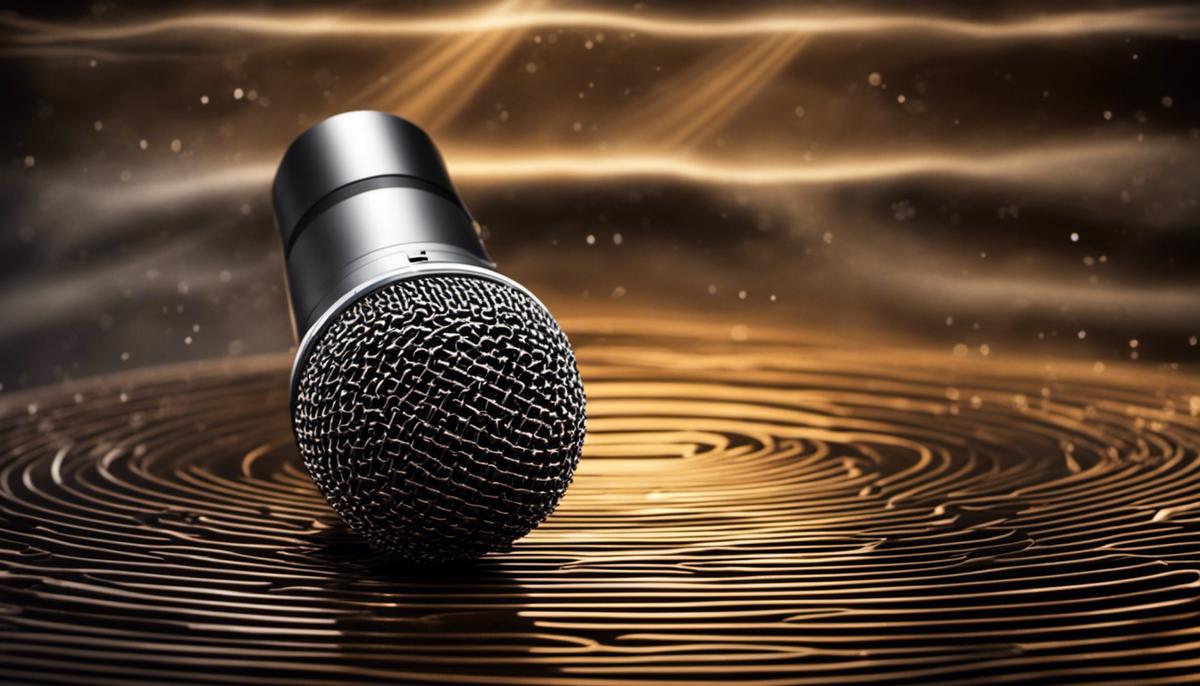
Assessing the Consequences of Microphone Bleed
Riding the sonic waves of the music universe, when one speaks of microphone bleed, a diverse range of reactions emerge. However, no passionate music lover or artist can deny the profoundly nuanced impact it has on the music we love.
Microphone bleed, although commonly looked upon as a blemish on the pristine body of audio production, carries with it an unconventional charm. It’s akin to the inadvertent smudge on an artist’s canvas – an imperfection that adds a touch of candid realism to an otherwise meticulously rendered façade.
Particularly in the realm of live music and festival sets, an environment we often find ourselves entranced by, microphone bleed can be an unsung hero. It is the shadowy accomplice granting us the unadulterated rawness and lifelike resonance of our favorite bands and artists. Like the ephemeral echoes soaring through the concert hall or the jubilant stir of crowd murmurs, microphone bleed mirrors these sonic specters to recreate the very fabric of a live music experience.
Diving deeper into the labyrinth of microphone bleed, one may ponder, is it possible to harness this phantom of sound? The answer lies in the strategy pursued by skilled audio professionals. By judiciously controlling the level of bleed and the path it takes, these sonic architects coherently blend individual elements, carving a unified soundscape. A reminiscent manifestation of this is the “room sound”, where the character of a space breathes life into a recording, mirroring the live experience for the listeners at home.
Furthermore, the field of acoustic music, with its intimacy and organic warmth, often relies on the controlled transgression of bleed. The interplay of instrument tones, the delicate hum of strings, all become a part of the greater auditory picture thanks to microphone bleed. What would a folk ensemble be without the shared essence of sounds merging, interpenetrating, participating in an intricate dance?
But in truth, it’s not just the acoustic or live music genres that can benefit from this intricacy. Drums, for instance, are a shining testament within electronic music genres, embracing the bleed between the different percussive elements for a cohesive, authentic sound.
The sophistication of microphone bleed encourages us to step beyond the confines of our previous understanding and embrace the symphony of sounds coloring our auditory world. Embracing the bleed is a testament to a true music lover’s quest for authenticity and depth. It compels us to widen our sonic panorama, unmask the binary of perfection and imperfection, and relish the harmony of their co-existence.
Hence, as we tread the vast cosmos of music, let’s remember – not every echo is meant to fade away into the void, and not every bleed is meant to be cured. For sometimes, in these overlooked spaces, the soul of music finds its potency and its truth. Music, after all, is a grand tapestry, and even the tiniest thread contributes to the majestic design. And isn’t that, dear connoisseur, what makes our beloved art form so breathtakingly beautiful?

Microphone Techniques And Gear to Minimize Bleed
Approaches to curb microphone bleed: Exploring techniques and gears
The crucial equilibrium of controlling microphone bleed is akin to choreographing a ballet of harmonious elements. It’s all about precision, finesse, and a keen understanding of the dance between sound and silence. Now that we have cast light on the whys and wherefores of microphone bleed, let’s delve into the influx of tactics used to control, or rather, to orchestrate it.
The mic technique plays a pivotal role in influencing bleed. The use of Cardio-Pattern Microphones, known for their heart-shaped polar pattern, can minimise undesired background noise and leakage. Positioning these microphones in a way that the back, which has the least sensitivity, faces the unwanted sources can be a game-changer.
Another pivotal player in this realm is the gooseneck microphone, a virtuoso at discriminating between the absence and presence of sound, ideal for musicians hunting down precision. Coupling it with windshields can drastically reduce unwanted noise caused by wind, breath, and pop noises, thereby reducing unanticipated bleed.
The use of Portable Isolation Booths has been heralded as a revelation within the music circles. This gear can isolate the microphone from the ambiance, ensuring only the sound projected directly onto the microphone gets captured.
Moving onto the tantalizing realm of production techniques, High-Pass Filters, or HPF, can effectively control microphone bleed. By filtering out frequencies below a certain threshold, these devices can drastically reduce the impact of bleed on the recording.
Similarly, proper use of compressor can also play a part in curbing the bleed. It can reduce the range of an audio signal by attenuating the output above a certain threshold, thereby reducing the impact of external bleed.
The art of managing microphone bleed straddles understanding the science of acoustics and the spirit of music creation. As we juggle different microphones, master the potential of gears and finesse production techniques, it starts to become clear that this isn’t just about blocking unwanted noise. This is about cultivating a sonic landscape, where microphone bleed becomes less of an intruder and more of a furtive component, inconspicuously contributing to the beautiful chaos that defines music.
Through this labyrinth of techniques and gears, what emerges is not a sterile, controlled environment, but a soundscape filled with real, organic vibrancy tuned to the rhythm of authenticity. Each approach mentioned isn’t an end unto itself, but a gateway, a way to shape the unsculpted sound, a way to paint the canvas of silence with a symphony of color. While microphone bleed might seem like a nemesis to be vanquished, it might just be a misunderstood ally, a part of the very fabric of the eclectic and wonderfully chaotic world of music recording.
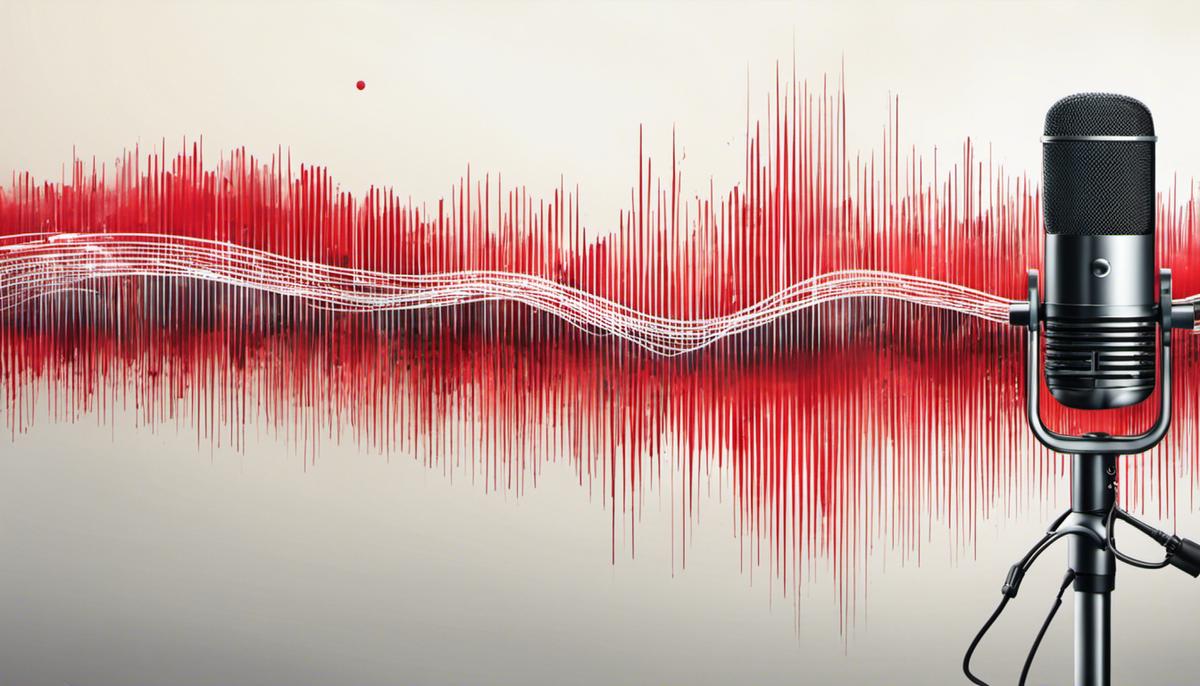
Post-Production: Tweaking Microphone Bleed
Unveiling the Art of Audio Engineering: Mitigating Microphone Bleed in Post-production
While microphone bleed, also known as spill or leakage, is often perceived as a challenge to quality sound recording, it also presents an opportunity for creative expression when harnessed and manipulated correctly. Conversion of this phantom force into an ally heavily depends on the prowess of a sound engineer. Let’s dive into how these audio wizards can master the art of dealing with microphone bleed in post-production.
Nothing screams precision in audio engineering louder than the use of Cardio-Pattern Microphones. These devices are known for their sensitivity being more concentrated towards the source of sound and less towards the sides or rear. Understanding the directional characteristics of these microphones can drastically reduce unwanted bleed.
Akin to the Cardio-Pattern microphones are Gooseneck Microphones, with their bendable features enabling the engineer to aim it toward the sound source. It reinforces precision and demonstrates how the art of sound lies in mastering even the most minuscule aspects of recording.
Defending the mix from environmental sounds like wind, breath pops, or even noisy sibilance is a craft in its own right. Utilizing windshields is a staple in this practice as they form a protective layer around the microphone, sparing your soundscapes from unwanted random sound intrusions.
Where windshields form a protective layer, Portable Isolation Booths build an entire fortress. They provide a small, contained environment that cuts off most of the surrounding ambient noise, thus significantly minimizing bleed.
In the digital post-production process, High-Pass Filters (HPF) prove to be a potent ally. They allow frequencies higher than a certain threshold to pass while reducing the lower ones, hence mitigating the bleed from bass-heavy elements.
Another tool within the post-production spectacle is the use of Compressors. These devices help manage the dynamics of the sound, taming those striking peaks that might cause unnecessary bleed through slight volume adjustments.
Understanding the science of acoustics and music creation is the bedrock for effective sound engineering. Acknowledging how sound waves interact with the environment and one another can lead to the creation of a fortified strategy to combat bleed.
Just like a painter wields different brushes to paint their masterpiece, a sound engineer must acquaint themselves with different microphones and mastering gear. Different mics have different propensities to pick up sound from various directions, and getting a hold of this knowledge is instrumental in tackling bleed.
Finesse in production techniques is where the marriage of science and art comes into the forefront. Creative positioning of instruments, thoughtful microphone placement, and crafty utilization of the recording space are few of the numerous techniques that can curb microphone bleed.
Shaping the sound and creating a sonic landscape not only brings forth the musical vision into reality but helps in managing the bleed as well. Strategic panning and equalization can create an engaging stereo image while keeping spill at bay.
Microphone bleed can be seen as a furtive component in music recording, impacting the recording subtly but surely. Recognizing its presence and potential influence is the first step toward either diminishing its impact or molding it into a contribution to the artistic vision.
Let the misunderstood ally in the world of music recording, the microphone bleed serve as a testament to the inventiveness of sound engineers. Navigating through the bleed can sometimes unleash new shades of creativity, providing a fuller, more naturalistic sound to the recording. Embrace it more fruitfully, and you might just be creating symphonies that sing not only to the ears but to the soul.

Undeniably, the world of sound recording is riveting, full of technical nuances and creative possibilities. The intricate journey of understanding and controlling microphone bleed guides us through it. It is these finer subtleties that can give a piece of music its unique identity; be it the raw, live textures that bleed imparts, or the clean and crisp sound achieved by minimizing it. Adequate knowledge of post-production tools and tweaks equips one to refine an audio track, often being able to make a significant difference even after recording. Thus, a mindful and informed approach towards microphone bleed can indeed be the distinguishing factor between an ordinary and an extraordinary sound recording.
In the artistry of sound recoding, finesse and attention to detail are as important as the technical equipment used to capture and relay the melody and rhythm. It’s a world that can seem overwhelming, teeming with pitfalls and pedantic details that could deter a novice or even the most tenacious of enthusiasts. However, experience teaches us that knowing what to avoid can often be more effective than knowing what to do. Within the realm of music recording, the seemingly insignificant factors such as room acoustics, compression dominance, and recording loudness carry considerable weight in determining the quality of your end product. This discourse explores the ten most common mistakes encountered in the recording process and thoughtful solutions to circumvent them.
The Bane of Over-Compression
The masterful brilliance of music lies in its raw power, its ability to evoke a gut-wrenching emotional response with just a few harmonious notes strung together. Consider a symphony. An orchestra poised with a multitude of instruments, each bursting with the potential to create an auditory allure that’s as complex as the human experience. This complexity, with all its peaks and valleys, quiet whispers and roaring crescendos, can get lost when music is over-compressed.
To understand the essence of over-compression, imagine a breathtaking landscape. Now envision viewing that landscape through a grainy, pixelated photograph. The technique of audio compression is not inherently harmful. In fact, it’s a crucial tool in the sound engineer’s arsenal, a honed skill that can adeptly balance the dynamic range in a musical piece. The issue arises when we fall prey to the lure of the loudness war.
The loudness war is a relentless push in the music production industry to make music as loud as possible, often achieved through an overbearing level of compression. But why, you may wonder? To make it more prominent, more notable when played amongst other tracks. Like a star screeching for attention in a sky already ablaze with a million celestial bodies.
Decibels may spike, but the depth and nuance of the music often plunge into an abyss. Over-compression can rob music of its dynamic range, hurling the hushed whispers and powerful crescendos into a small, confined box. The melody begins to lose its soul. It’s like forcing the vastness of the Grand Canyon into a small fishbowl. Sure it’s contained, but what’s lost in the process is what makes it magical.
But don’t worry, this is not a portent of doom. The last decade has seen a turning tide against this incessant race for loudness; instead, there’s a surge towards quality. Remember, beauty often lies in the subtleties. In music, it’s the staccato notes lightly skipping over the ebb and flow of melody. It’s the haunting echoes of a guitar riff that linger long after the song has reached its ultimate cadence. Each beat, every pause, and shift in volume is a throbbing heartbeat in the body of the song – it deserves to be heard, to be felt in its entirety.
While compression continues to have a pertinent role in the transformation of raw recordings into polished pieces, a prudent hand in its application is necessary. After all, it’s about striking the right chord between the powerful and the delicate, the high notes, and the quiet strumming at the fringes. This balance, when respected and nurtured, can transport you to the heart of the music, with every beat echoing the artist’s passion and your own resonating in perfect harmony. Bring back the dynamic range, those quiet whispers and roaring crescendos, and allow music to breathe, to pulse, to make you feel alive. Yes! That’s what music should do – ignite your spirit and stir your soul. Because when every note matters, music becomes a symphony magnifique.
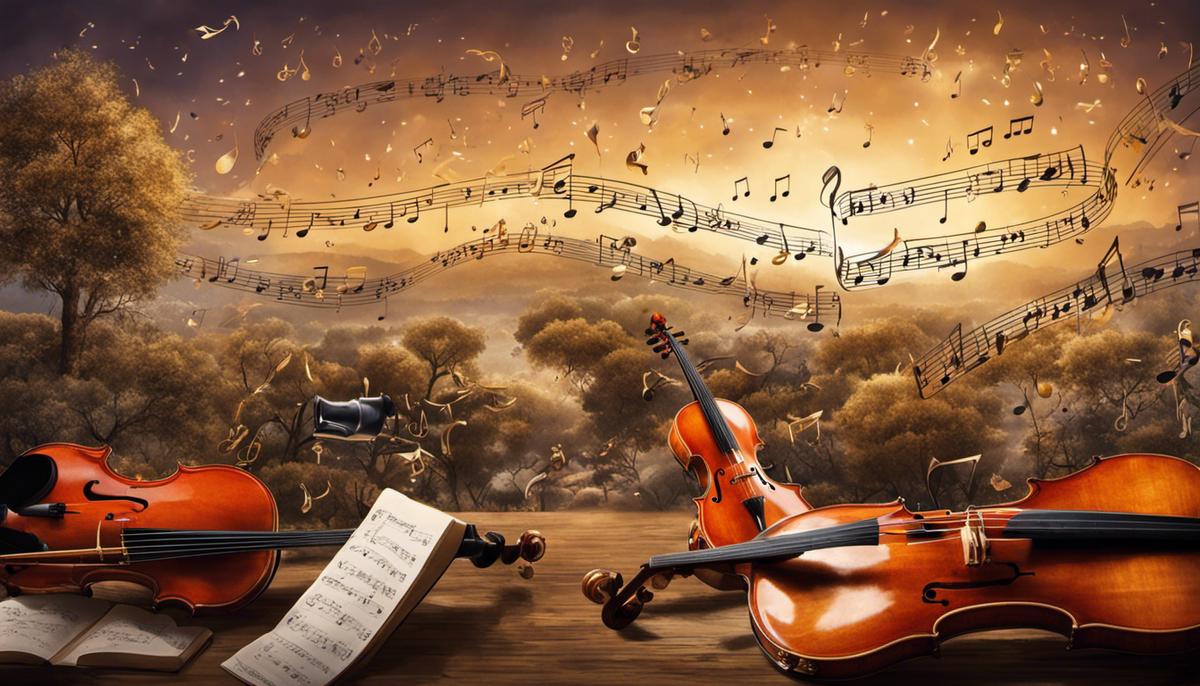
The Ill Advise of Recording Too Loud
Nothing unites people from all walks of life like music; it’s the one universal language everyone can understand. But as much as we all adore the thrum of a bass guitar, the heart-stirring croon of a lead vocalist, or the painted landscapes shaped by a composer’s mind, there’s growing concern about the titan of sound pressure we’re unleashing within our songs. From the recording studios’ sleek control rooms to the intricate stage setups of music festivals, are we being drawn into a dangerous dance with decibels?
The act of crafting sound is much like sculpting, gently chipping away at a block of marble until a masterpiece stands before you. Every note holds potential. Every silence paints a canvas of equilibrium. The process of recording involves understanding these elements and knowing their place within the symphony. But when we over-amplify the sound during the initial recording, it’s akin to placing that beautiful sculpture in front of a blinding spotlight. The real masterpiece is overshadowed; all we see are glaring highlights and harsh shadows, robbing audiences of the chance to fully appreciate the artist’s work.
Audio clipping is another casualty of this sonic arms race. This phenomenon manifests as distortion, rendering music as a sheer cacophony rather than a harmonious blend of tones. It’s not just the classical music aficionados or jazz purists who mourn this lack; even headbangers at rock concerts know when a delightful riff has turned into a dissonant roar. The desire to push the sound to its limits might seem riveting in theory, but the reality is often a lesser version of the true masterpiece.
Moreover, what’s becoming hard to ignore is how, in this quest for a louder sound, we’re risking our hearing health. Extending the toll beyond fidelity, sound engineers, musicians, and dedicated aficionados spend extended hours exposed to high decibel levels. Left unchecked, it’s a sure-fire recipe for tinnitus and noise-induced hearing loss. Hearing, once lost, is irreplaceable; it’s a high price to pay for a loudness that may not necessarily add value to the music experience.
While it’s crucial to explore the boundaries of sonic creativity, it’s as vital to prioritize the human aspect of music. After all, music is a shared experience; it’s vibratory patterns that connect hearts and minds across continents. Let’s honor this gift by appreciating the intricate dynamics of sound – the soft whispers of a violin solo, the gentle build-up of a rock anthem, the emotional eruption from a choir. The power of music lies not just in how loud it can get – but in its ability to touch souls, at any volume.

The Ignored Importance of Room Acoustics
Stepping into the depths of sound – it’s a thrilling adventure into the recesses of sonic timbre and tonal landscapes. Like a painter delicately applying meticulously mixed hues against a blank canvas, music creators weave sounds into symphonies that engage, inspire, and connect.
Overlooking one central aspect in this intricate process, however, can be akin to viewing this painting through a murky glass. That aspect is the very space where the music is birthed – the recording room.
When joyous melodies pirouette through the air of a recording room, the room listens. It absorbs, reflects, and even manipulates those rhythms and harmonies that resonate within its boundaries. Do we, immersed in our acoustic pursuits, ever stop to listen back?
The acoustics of our recording room can subtly yet significantly affect the atmosphere and, indeed, the soul of the production. It is like an invisible hand that gently cradles the notes, caresses the harmonies, and guides the dynamics towards musical fruition.
Material, size, shape, and furnishings within a room can twist the ebb and flow of sound waves, nudging them into places where they bounce, echo, and eventually shape your music’s final sound. An undisciplined echo, an offending frequency, or a belligerent bass might all originate not from the music itself but from the room serving as the performance’s stage.
It isn’t a war against reverberation or an attempt to quell the rogue echo. It’s about understanding and harnessing the power of space, tapping into the veins of resonance and timbre that flow through the anatomy of your recording room. Our spaces breathe with us, their every inhalation and exhalation in sync with the rhythm of our melodies.
In our pursuit to protect the essence of music from becoming a casualty in the loudness war, are we possibly neglecting another battlefront right in our recording rooms? As we contemplate the organic beauty of sound, its nuanced echo in our spaces, and the phenomenal auditory experiences they can create, let’s lend our ears to the silent song sung by our recording rooms. Only then might we truly bring our music to life with the soulful authenticity it deserves.
In the end, music is emotion. Its power to stir hearts is unparalleled. And perhaps, it’s time to acknowledge that the symphony we create isn’t just nurtured by our musical intentions and skills, but also by the often overlooked acoustics of our cherished recording room.
Listen. Experiment. Understand. Let our rooms sing back to us as we explore this incredible sonic journey. Because when we create music, every note and its echo matters.

As artists and hobbyists, the perception of mistakes can often feel counterproductive, holding us back from realizing our full creative potential. Yet, overcoming these mistakes is a journey well worth embarking on, as it can significantly improve the end result, while enriching our understanding and enjoyment of the recording process. Thus, by adopting a balanced approach to compression, monitoring the loudness during recording, and giving due consideration to room acoustics, we can steer clear of the more common recording pitfalls. In doing so, we empower ourselves to create productions that are rich in dynamic expression and devoid of artificial constraints, ultimately resonating with our listeners on a deeper, more meaningful level.
In the vast and complex realm of music production, the seemingly minute yet profound element known as the ‘click track’ holds importance that can’t be underestimated. With its history deeply rooted in the annals of sound engineering, the click track has evolved to become an indispensable tool for musicians and producers alike, crafting detailed audio tapestries with rhythmic precision. This essay aims to unpack the intricacies and quirks of click tracks, from its integral role in shaping the quality of a musical piece to the technological advancements that have honed its relevance in recent times. Laced within are insightful case studies where the timeless tunes in our playlists have danced to the rhythm of the click track, making music what it is today- an aural delight.
Understanding the Click Track
Stepping into a heartbeat, measuring the pace of pulsations; that’s what beginning a music piece feels like. The rhythm sways, setting a rhythmic vista, radiating uniformity and consistency so crucial to a track’s soul. This founder of rhythm, the lodestar guiding the melodic ship, is none other than the humble, oft-unsung hero: the click track.
At first blush, the click track might seem like a mere rhythmic metronome. But it’s more than that. It’s an invisible member of the band; an unassuming shepherd leading the musical flock to coherence. The unsung conductor weaving a symphony of tunes, the click track carves out a vital role in the recording process.
To dissect the world within a click track, one needs to embrace its mechanism. It’s not a frivolous noise in the background. It emanates a series of audio cues, offering the ever-so-required synchronization and timing for all engaged in the performance. As simple as it may seem, the click track is the melodious storyteller, narrating each note’s when and where, hiding behind the curtain while the show goes on, the quiet lighthouse guiding the ship to safe harbor.
Digging deeper into the intertwining threads of a click track’s role, its significance cannot be understated during multiple takes or multitracking in a recording session. When layers of various harmonies and instruments are stacked, synchronization is paramount. And who’s the maestro pulling all strings together? The click track, shrouding everyone under its rhythmic umbrella, ensuring that the plethora of tones dance together in harmony, not stepping on each other’s toes.
Remember, that sound engineers, those magicians in the studio, rely heavily on click tracks. It makes their work smoother, with the decibel timing being the thread between tracks. The tempo mapping becomes seamless, and punching in and out of the live recording avoids any disturbance in the musical continuum. The music weaves in and out effortlessly, guided by the invisible thread of the click track.
Moreover, in our age of unstoppable technology, the click track juggles an assortment of roles. From cueing synths, controlling light shows incorporating pyrotechnics, to even aligning the stage smoke, the enthralling spectacle of a live show is orchestrated in part by the click track. A steady rhythm not only ties together the intricate tapestry of sound but synchronizes an impactful visual experience.
Much to the bewilderment of many, the click track works in mysterious ways. It lives in the shadows, the cognitive phantom guiding the symphony; invisible, yet influential. It’s the silent clock tick-tocking in the vast auditorium of melody, marking the pace of every note and chorus. A pedestrian listener might not realize its existence but peel back the layers, and you find the click track, standing tall and crucial in the world of musical magicians.
The true power of the click track lies not in its sound, but in its silence, its skill of operating subtly. It is the unseen melody, the uncredited rhythm, laying out the canvas for the music to play with splashes of vocal tones and instrumental colors.
So the next time you get lost in the mesmerizing labyrinth of music, remember to appreciate the invisible maestro, the click track, whose silent whispers breathe life, rhythm, and synchronicity into every note that reaches your ears.
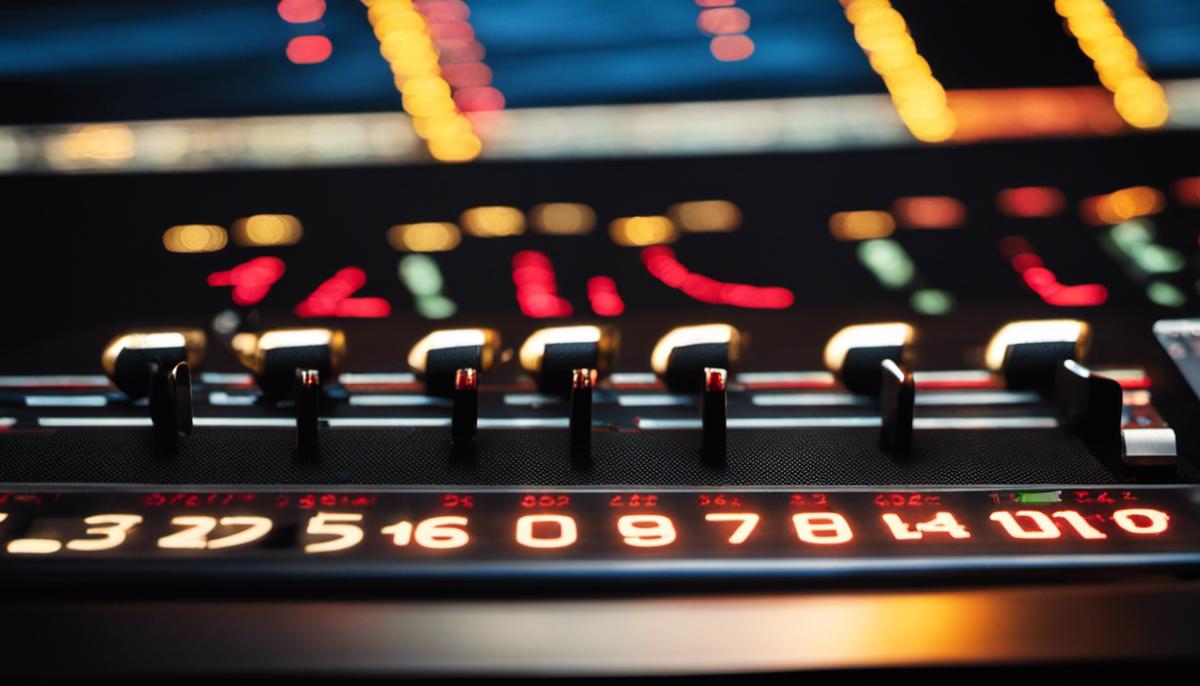
The Relationship Between Timing and Musical Quality
“Accurate Timing: The Pulse Behind Artistry and Resonance in Music”
A symphony of sublime acoustics or a riotous rock concert – what is the omitted denominator that harmonizes each note into a sensational melody? With the omnipotent but behind-the-scenes pulse of a metronome or click track, the real maestro, having already been examined, let us delve deeper to comprehend how precise timing modulates the overall allure and quality of a musical masterpiece.
Every pulsating beat in a musical composition is analogous to the rhythm of a heart. As intricate as lacework, this heartbeat crafts an enthralling cadence that manages to whisper to the soul, command a foot to tap, or coax tears from a listener’s eyes. With the same austerity as the nation’s constitution, the integrity of a piece stands on the important tenet of accurate timing.
Elaborated as the milliseconds that separate amateur from virtuoso, precise timing is the defining factor that moulds an auditory experience. Picture a snare drum smacking its sharp, crisp note a millisecond too soon or too late. It skews the very skeleton on which a piece of music stands, compromising melody and rhythm, that ultimately leads to a discordant audio experience. Visualize accurate timing as orchestrating notes along the timeline of a track, a conductor coordinating the dance between melody and rhythm, dictating the rise and fall of a symphony, or blending the pitch-perfect vocals cruising above guitar shredding.
To understand the magic imbued in precision further, let’s venture into the realm of jazz and reggae, where timing fluctuates as per artistic interpretation. The unique syncopation of ‘offbeat’ notes lends these genres their characteristic charm. This flexible timing, or “swing time,” permits musicians to articulate emotion, inducing a creativity-sparking variance. Thus, accurate timing in this context is not just confined to mechanical precision, but also involves a dynamically nuanced comprehension of rhythm that entrusts the performers with regulating timing to enhance their expressive potential.
Diving into the hemisphere of the audience, accurate timing also shapes how music is perceived. Have you ever noticed your foot automatically tapping in response to a catchy tune? This phenomenon, referred to as ‘entrainment,’ stems from the accurate timing embedded in the music. Humans have a natural propensity to synchronize movements with a rhythm pattern. When beats are punctually delivered, it allows listeners to carve a physical and emotional connection with the music- swaying, dancing, or simply absorbing the synergy spun around them.
Certainly, while on the journey of constructing a musical piece, unleashed creativity and fervent composition are crucial. Nonetheless, these elements resonate potently only when they synergize with the carte blanche bestowed by accurate timing. As a true testimony to the chi of music, accurate timing gifts musical pieces their pulse- a life force that resonates within the listener and arouses the gamut of human emotions within their soul.
Ultimately, the beat whispers its silent mantra, ‘timing is everything.’ Its pulse embedded within the symphony of notes and silences, accurate timing, fuels the heart of music, knitting together the essence of raw passion and refined artistry, producing a tapestry that is by every means- a masterpiece.
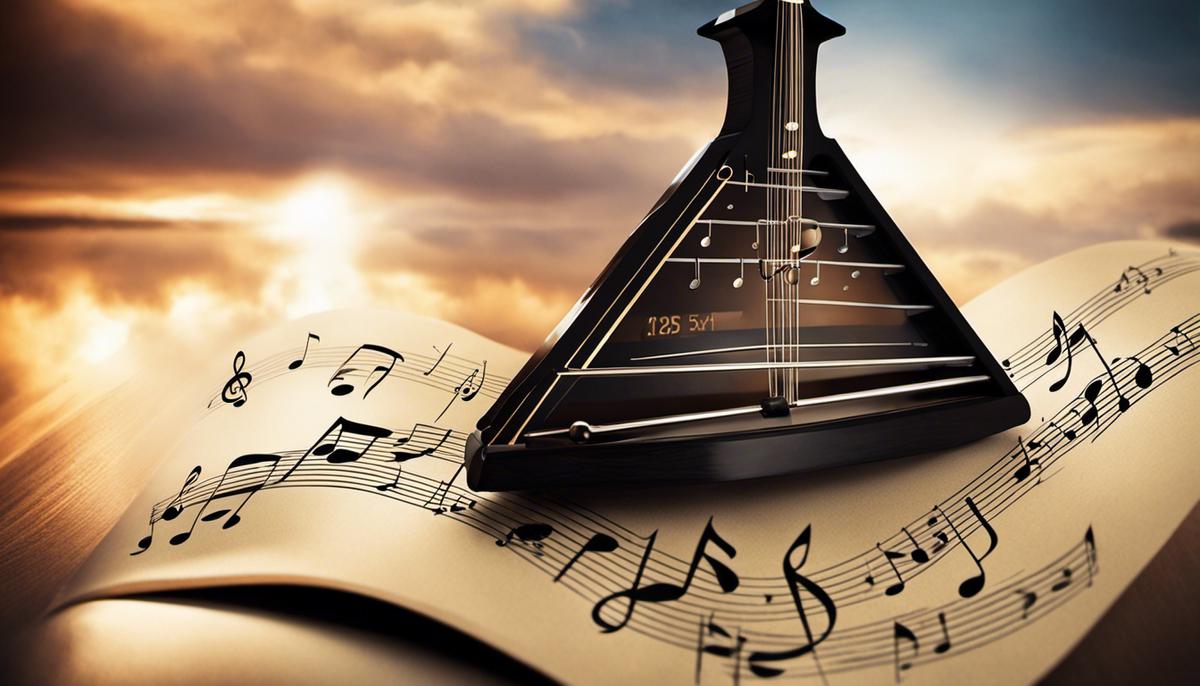
Advanced Click Track Techniques
Foraying into the deeper echelons of music production and performance, the click track emerges as the beating heart, a digital maestro, driving musicians towards luminary heights of virtuosity. Let’s delve into advanced strategies artists and producers use with click tracks to encode melodies with life, rhythm, and soul.
While the click track’s fundamental purpose is providing synchronization and tempo, advanced musicians are harnessing this tool in innovative ways that extend beyond just basic timing. One such strategy is layering of click tracks. By using multiple click tracks simultaneously, musicians can construct rhythmic textures that epitomize complexity and ebb with layered nuances. This technique is incredibly empowering for granting total control over the tonal structure, thus enabling rhythmic creativity to flourish unrestrained.
Another sophisticated maneuver with click tracks involves flexible tempo mapping. It is a technique where the tempo is intentionally varied over the course of a song to evoke an array of emotional responses—an elusive effect when sticking with a single metronome setting. The variation in tempo provides a semblance of the human touch within the calculated precision of the digital milieu, fostering a more organic musical experience.
Complementing the flexible tempo mapping, the use of accelerando and ritardando—gradually speeding up and slowing down the tempo—within the click track is another advanced strategy. These subtle tempo changes can drive a change in both the emotional contour and the narrative curve of a song, immaculately aligning the pace and intensity of the music with the lyrical subplot.
Augmentation of the click track with auditory cues is another game changer. Adding in auditory cues, such as strikes or chimes, to signify transitions, such as verse-to-chorus shifts, further enhances the correspondence between musicians during live performances and recording sessions. This cueing system arms musicians with the perceptual tools necessary for crafting the musical masterpiece where each nuance is attuned to the overarching rhythm and melody.
In the realm of electronic music, producers have begun automating parameters within the click track, regulating factors like reverb, pan, and filtering. Thereby not only creating intricate rhythmic patterns but also exploiting the sonic space, thus moulding the soundscape dynamically in compliance with the music’s emotional undertow.
The culmination of these advanced strategies infuses the creations of musicians and producers with an unmatched temporal control and ravishing rhythmic resonance. The click track, therefore, carves its niche as not just an invisible metronome, but a tool for injecting depth, dimension, and dynamism into the music. Indeed, the true power of the click track lies in its adept ability to unshackle the chain of rigid timing, unfurling a world where each pulse, each beat, each rhythm is a conduit to explore the boundless canvas of musical creativity.
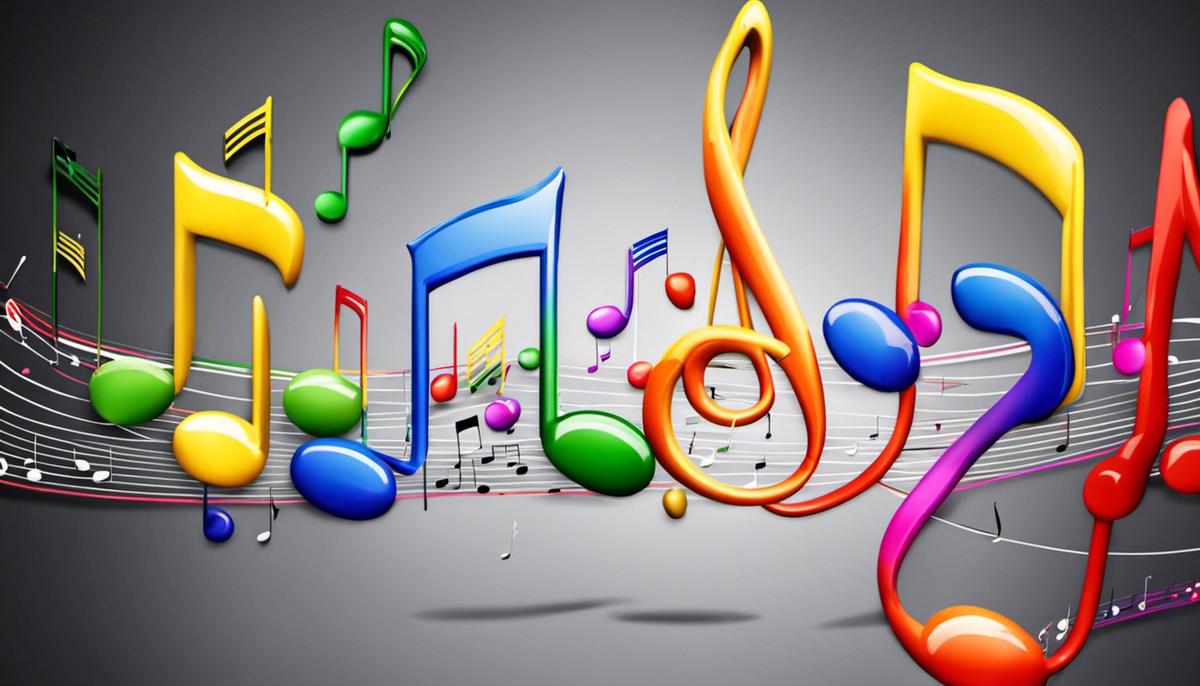
Impact of Technology on Click Track Usage
As we pull back the curtain on the musical universe, the click track stands there – its rhythmic heartbeat pulsating through the veins of countless symphonies, choruses, blues jams, and head-bang inducing metal anthems. With relentless steadiness, this unsung hero shapes soundscapes, empowers performers, mesmerizing audiences across the globe. It’s time we delved into the mind-bending world of technological advancements and saw how they’re redefining the boundaries of what the humble metronome can achieve.
Music, as art, has always held hands tightly with technology – stretching boundaries, discovering uncharted territories. Technological advancements have made audible frequencies, that once echoed through grand concert halls, accessible to humble living-rooms and commuting ears. Currently, technology is breathing new life into timekeeping mechanisms, reshaping the way the click track interacts within the music creation process.
High-tech soundboards and software enable layering of click tracks, providing unique time signatures for different musicians within a single song. It’s like a symphony of metronomes, each beating to its drummer’s tune, creating an impeccably timed harmonious whole. Complex musical pieces, demanding a variety of time-signatures, dance effortlessly under this guidance.
With flexible tempo mapping, music producers can adjust the beat on the fly to capture crescendos of emotion. This empowers composers to add ebb and flow to the rhythm, embedding accelerando and ritardando within the click track. What once was a static pacer, now dynamically strides alongside the beating heart of the piece.
Especially fascinating is the use of auditory cues to supplement the click track – akin to auditory signposts guiding the musicians on their crossroads. Elements such as swelling pads or chimes can mark section changes in real-time during a recording session, providing seamless transitions.
Venturing into the pulsating terrain of electronic music production, automation of parameters within the click track has become a revelation. Producers can automate volume swells and filter sweeps, lending an additional layer of nuance to the rhythmic constituent of the track. This creates a unique interplay of rhythm and sound color never seen before.
The path being tread by these technological advancements brings the click track out of the shadows and into the spotlight. Transforming it into an accomplice of the creative process, rather than just a clinical precision tool.
Technology, thus, doesn’t just facilitate musical creation – it challenges, inspires and redefines music and its instrumental companions. The metamorphosis of the click track from the metronomic guardian of timing to an intrinsic part of the exploration and expression of music is a testament to this bond. It demonstrates that musicians, technicians, and innovators together are cultivating a landscape where technology’s pulse beats in rhythm with the very heart of music.
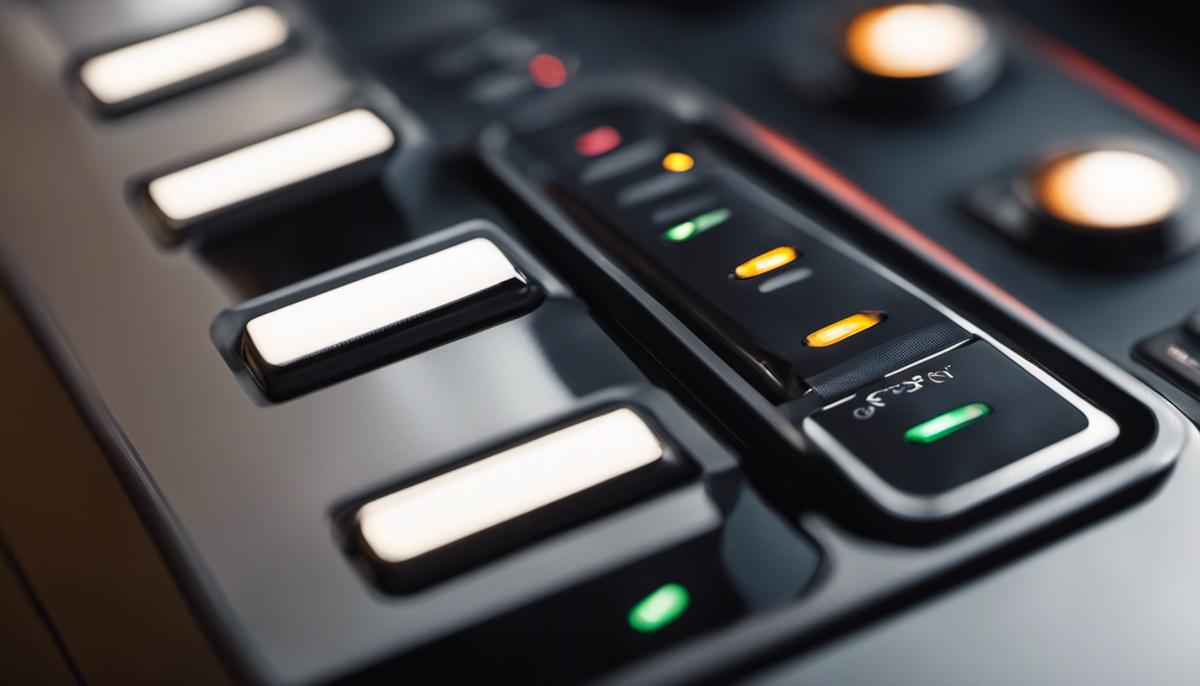
Case Studies: Role of Click Track in Iconic Songs
Tuning into the archives of world’s most iconic songs, one gets an awe-inspiring musical treat. An invisible conductor weaves magic, joining varied strings of melody, rhythm, harmony, into a symphony that transcends boundaries and unites hearts. But ever wondered what wields the magic wand to create this extraordinary chorus of cheer and resonance? Right, you got it – it’s the click tracks!
Remember Led Zeppelin’s “When the Levee Breaks?” The thunderous drums that gave the rock ballad an echo effect! Little do many know that it was the artfulness of the click track that made the drums reverberate throughout the song. Bacchanalian beats synchronized with absolute precision, the emotion of rebellion resonates through variegated tempo mapping, all helmed by the click track.
Who can miss The Rolling Stones’ classic “Honky Tonk Woman”? The stellar composition features a cowbell supplemented by the click track, adding a zesty living pulse to the rhythm. The click track thus transforms from a star backstage, the invisible metronome, to an on-stage artist, leaving an indelible auditory cue in our minds.
Moving towards the realm of pop,”Billie Jean”, Michael Jackson’s stunning masterpiece, presents the perfect alliance of the click track with electronic music production. The track’s unforgettable bassline rhythm, so smoothly aligned with the click track, gives a sturdy backbone to the song, making it a perpetual favourite across generations.
Legends like Pink Floyd took the augmentation of click tracks to a whole new level. In their surreal ensemble, ”Time”, they introduced flexible tempo mapping, using increased accelerando and ritardando that created a more poignant and alluring tune. As the song passes from one phrase to another, from the sonorous tick-tock to the alarming bell rings, the music lurches, intoxicates, and numb the listeners. A guitar solo that’s claimed its place in the Hall of Fame, intricate layers of click tracks create a unique time signature that has inspired countless musicians around the globe.
As demonstrated, the click track has been an unsung hero, a conduit of creativity catalyzing the energy, rhythm and spirit of some of the most iconic songs in history, majorly shaping their far-reaching impacts. From Rock ‘n’ Roll to symphonies, from Jazz to electronic, the precision of the click track has assisted in transforming raw artistic ideas into quality composition.
As music aficionados, while we toe-tap to the beats, sway with the rhythm, and hum the melodies, let’s also pay our tributes to the click track – the heart-throb, the pulse generator, the unsung maestro, which keeps the musical world in rhythm.
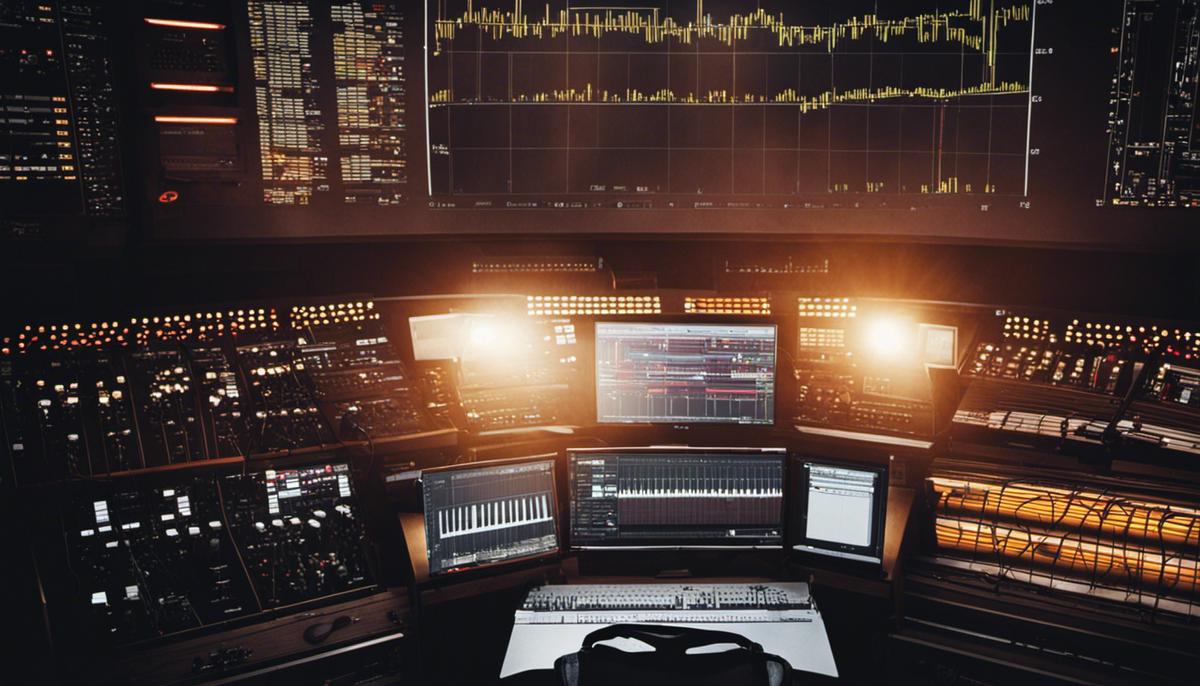
As we traverse through the extensive landscape of musical prowess, the humble click track rises as an unsung hero, propelling music to the heights of perfection. Its intricate dance with timing peppers every piece with personality while technological innovations continuously redefine its artistry. Buried within the heartbeat of iconic songs, the click track stands testament to the symphony of timing, accuracy, and emotion that characterize music. Nonetheless, the adroit application of advanced click track techniques requires skill, astuteness, and an innate passion for sound – attributes that, when honed, can transform any hobbyist into a maestro. The harmony within the cloak and dagger world of click tracks continues to resonate, painting a myriad of rhythms that underline where we’ve been, where we stand, and the multifaceted musical cadences to which we’re headed.
The art of vocal harmonies is a symphony, where voices intertwine to create something magical and melodious. This captivating vocal arrangement is much more than merely singing different notes at the same time. It involves understanding the structure of vocal harmony, developing keen listening skills, and acquiring adeptness at recording multiple vocals simultaneously. Comprehending the concept of melody versus harmony, exploring the intricacies of chord structures, and developing an ear for pitch, tone, and rhythm are fundamental elements in mastering this art. The goal is to blend these harmonious elements seamlessly, creating an immersive auditory experience that moves and resonates with listeners.
Understanding Vocal Harmony Structure
Harmonizing Grace: Unraveling The Secret Of Harmony Structures In Vocal Recording
In the euphonic universe of music, harmony is not just a musical technique but an interplay of emotion, expression, and rhythm that shapes the soul of the melody. The intertwining of voices in harmony produces that exquisite mosaic effect that engages the listener and pulls them into the heart of the piece. It’s the secret ingredient that adds depth and dimension.
Harmony is the symphony beneath the melody, like a painting beneath the brush strokes. It has the power to elevate a single tone into a symphony that resonates within the heart of the listener. But exactly how does harmony come to life in vocal recording? Let’s dive into the deep end of the harmony structure pool and discover its secrets.
First, harmony must have a root. In the language of music, the root is also regarded as the “tonic” or the first note of a scale. The root note or the melody line provides the fundamental stepping stone to building the harmony.
Next comes the harmony’s strings—thirds and the fifths. If a melody lies on the root or the ‘tonic’, the harmony’s base will be in the 3rd and 5th notes on the scale. In simple terms, if the melody line is singing a ‘C’, harmony singer one would ideally adopt an ‘E’ (third) and harmony singer two, a ‘G’ (fifth).
Harmony then blossoms through chord progression. In a typical vocal recording, songwriters cycle through different chords while maintaining the melody. Usually, the chord progression in a piece follows a particular sequence known as the “Circle of Fifths”, but the freedom of creative expression allows for interesting and innovative progressions.
Following the creation, there is Conversational Harmonization. This technique is making waves in vocal recording. It involves the adjustment of harmony phrases to correspond and “converse” with the melody line, creating an enchanting back-and-forth, a dialogue of tones.
Intricacies of harmony don’t end here. There is also Antiphonal Harmonization, which creates a “call-and-response” pattern, and Ostinato Harmonization, where a repeating motif runs like a thread tying the harmony together.
Finally, a balance must be found. Too much harmony can overshadow the melody, and too little can leave a song sounding hollow. Like salt to soup, harmony should enhance, not overwhelm the melody.
Crafting a harmonious structure in vocal recording is not just about the technicalities—it’s about the artistry. It’s about blurring lines between different notes to create a masterpiece that resonates and throbs with life. With the right understanding and a dash of creativity, a song can be woven into a tapestry of harmony that sways the listener and immerses them in its rhythm.
More than knowledge, harmony requires practice, intuition, and a profound love of music. With these tools at hand, anybody can unravel the mystical chords of harmony, and craft a symphony that reverberates far and wide, uniting audiences in the universal language of music. Each harmony created then becomes a word, a sentence, a paragraph in the age-old narrative of human emotion, written in a timeless tongue everybody innately understands and responds to—Music.
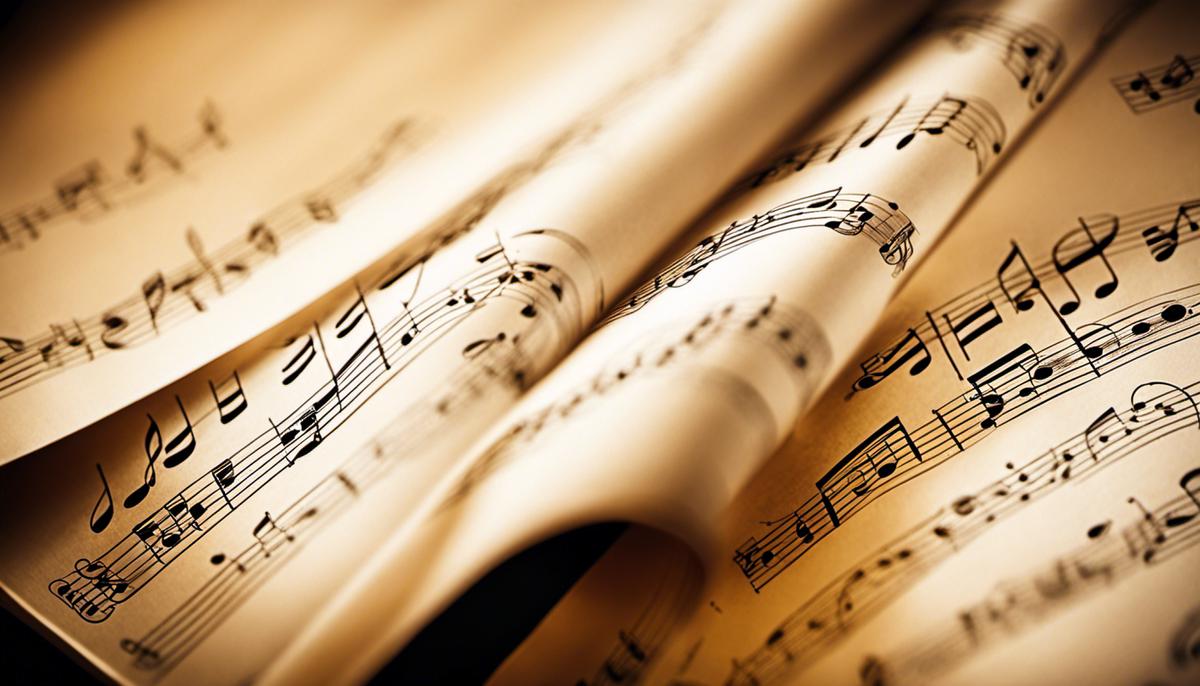
Developing Your Listening Skills
Configuring Your Harmonic Radar: Carving out Vocal Harmonies with Precision
Once you’re familiar with music’s essentials – root notes, chord progressions, thirds and fifths, and common techniques of harmonization – wrapping your ears around the fine details of harmony might require a little more attention. Just as a master painter imbues their final brush strokes with a touch of finesse, your auditory keenness can be polished to perfection, to grasp the finely nuanced vocal harmonies that are at the heart of our favorite melodic compositions.
First, we’ll dive into a concept we’re calling ‘harmonic dissection.’ This process stems from a purposeful repetition of a song with the intention of slicing it into its key components. This allows you to concentrate on the entire harmonic backbone as a solo entity, dissecting the intertwined vocal interplay by focusing on each individual layer. The best avenue to achieve this is by employing high-quality earphones. In-ear monitors, renowned for being highly isolating, offer an excellent choice for the discerning music aficionary intent on honing their harmonic acumen.
Among the must-have skills is the ability to identify and familiarize oneself with intervals. An understanding of the pause or ‘gap’ within notes makes for an essential navigational compass while charting the expansive sea of harmonies. Begin listening by searching out these intervals. Solfa, an ear training technique often used in musical education, can be your best ally here. Employing the solfa methodology to recognize different note intervals can sharpen your harmonic intuition.
Next up: the application of ‘active listening.’ This targets, not the passive listener, but the engaged maven who consciously pays heed to the harmonic nuances in a song. Often, while paying attention to the leading vocals or primary melody, we tend to overlook the subtlety underlying harmonies lend to the overall musical landscape. These essential elements add texture, depth, and color that make a composition unforgettable. Taking the time to develop active listening evolves your overall music appreciation by unveiling the hidden harmonic stratospheres that often lay unnoticed.
Another important tactic to cultivate harmonic mastery is by singing along with your favorite records. Though seemingly rudimentary, this technique actively engages your vocal chords and audial perception, symbiotically illuminating the road to harmonic prowess. Initiate this by starting with the melody, then veering off into harmony’s fascinating backroads, finding the less-travelled pathways that guide you into a deeper understanding.
Venture a step further and challenge yourself with ‘harmony mapping.’ This endeavor involves jotting down, visually sketching, or mentally picturing the full harmonic pathway of a song. In essence, you plot the harmonic shifts and transitions in a composed piece, availing a richer blueprint of its harmonic design. This exercise of ‘seeing the unseen’ opens divergent avenues of perception creating a more holistic understanding of the music you consume.
Witnessing live music can be a harmonically enlightening experience. It presents an unadulterated view into the intricacies of harmonies, showcasing how musicians meld individual voices into one symphony. Whether it’s an intimate gig in your local bar or an electrifying set at a music festival, the live music scene is a vibrant laboratory for harmonic exploration.
Collectively, harmony, when accurately perceived, broadens the auditory vista, converting the music experience from monotone to technicolor. Its atomic precision, coupled with sprawling imagination, culminates in a vivid universe of sound that lingers long after the final note fades away. So, immerse yourself, tune in, and let harmony illuminate your musical pathways.
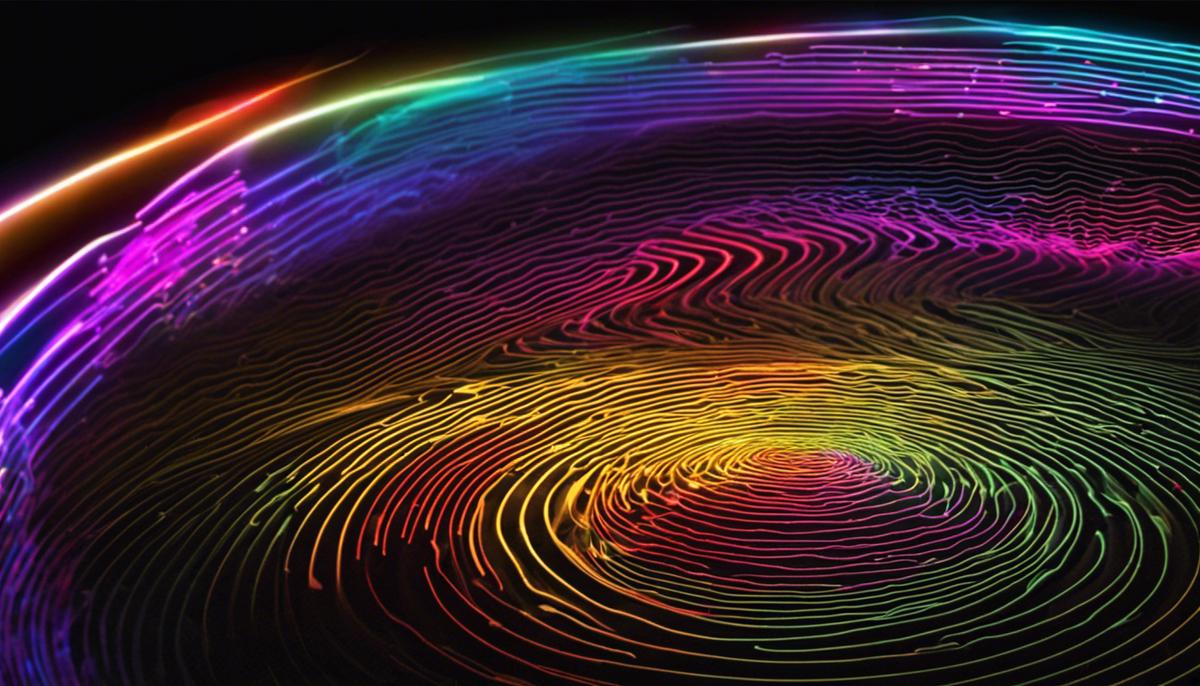
Techniques for Recording Multiple Vocals
Crafting a vocal harmony that reverberates with the soul and resonates with the heart is an art of musical mastery.
This begins with the process of recording multiple vocal tracks effectively. Each voice is a color in the artist’s palette, adding depth, emotion, and texture to the musical canvas. This piece will converse about methods to bring those vocal tracks together in a harmonious symphony.
Starting off, let us talk about ‘Layering’. Consider the song a layered cake, each layer should enhance, and not overpower the other. Record the harmony layers separately, giving attention to each line as its entity. Everyone involved must articulate and tune their vocal parts perfectly to prevent any imbalance in the final mix. Use a quality microphone and avoid unnecessary effects during this stage; it’s all about capturing the raw, unfiltered expression of the vocals.
One technique that music aficionados swear by is ‘Panning’. This involves distributing the sound in a stereo or multi-channel sound field. For harmonies, it’s effective to pan different vocal tracks slightly off-center, allowing the primary vocal track to remain dominant while the harmony vocals surround the listener, creating a rich, immersive experience.
Audio editing software, like Pro Tools or Logic Pro X, can be your trusted ally in crafting beautiful harmonies. These programs provide functions like ‘Pitch Correcting’ and ‘Time Aligning’, which let you fine-tune each track, ensuring they blend smoothly. Remember, tools like these are to augment your creative vision, not dominate it; let organic originality reign.
Another significant aspect of recording multiple vocal tracks is the ‘Mic Technique’. Vocalists must keep the right distance and angle from the microphone; this can vary according to the voice type and the mic used. Experiment with this till you find the sweet spot, where the voice is captured accurately.
‘Track Doubling’ can also bolster harmonies. In this technique, each vocal track is sung and recorded more than once. It has been widely used by eclectic musicians such as The Beatles and Led Zeppelin. If layered carefully, doubles can fortify the vocals, enhancing the texture and depth, making the harmony robust and captivating.
Lastly, upon recording, it’s now time for the ‘Mixing’ phase. Balance the levels, apply creative effects like reverb or echo, and accentuate certain vowel sounds. This process will meld the voices into an interconnected musical experience.
Let this guide punctuate your recording sessions with triumphant exclamations of harmony. Remember, the ultimate goal is to paint a soundscape that stimulates listeners, transports them to an aural utopia, and binds them through the sacrosanct language of music. Each voice, each note, is a potent whisper in the hum of the cosmos, contributing to the all-encompassing symphony of harmony. So, take the plunge, tap into your creative soul, and forge harmonious vocal tracks that echo through eternity.
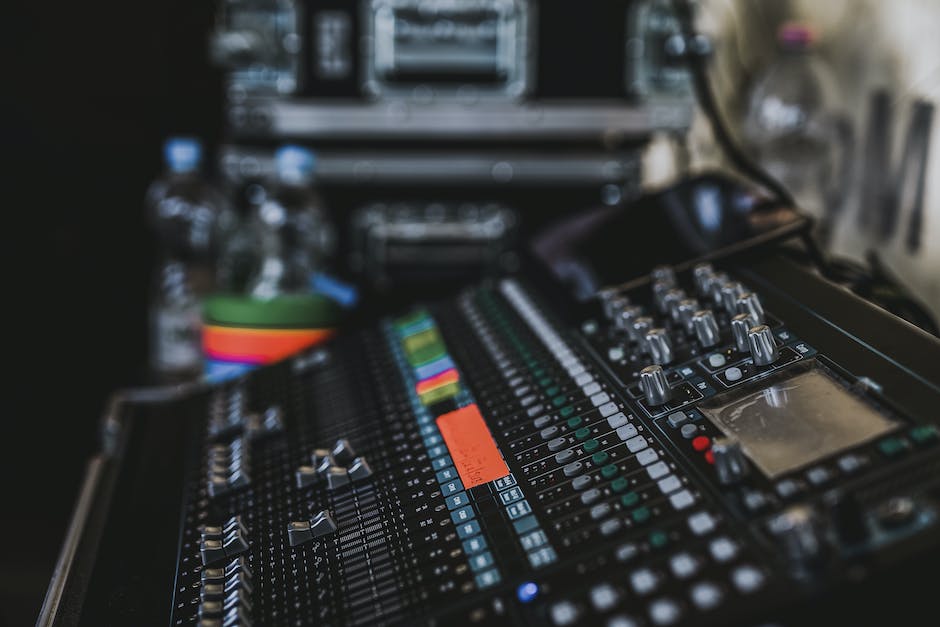
As we delve into the artistry of vocal harmonies, it becomes clear that the path to creating perfect harmony is about careful craftsmanship. With a deep understanding of vocal harmony’s structure, sharpened listening skills, and the proficient execution of multiple vocals recording techniques, one can indeed create mesmerizing harmonies that amplify the emotional resonance of a song. Remember, the beauty of vocal harmony lies in its blend – each individual voice contributes to the whole without losing its unique essence. As you continue to experiment with these techniques and refine your skills, may you find joy in the journey and elevation in the harmony you create.
Page 2 of 5 « 1 2 3 4 5 »



















